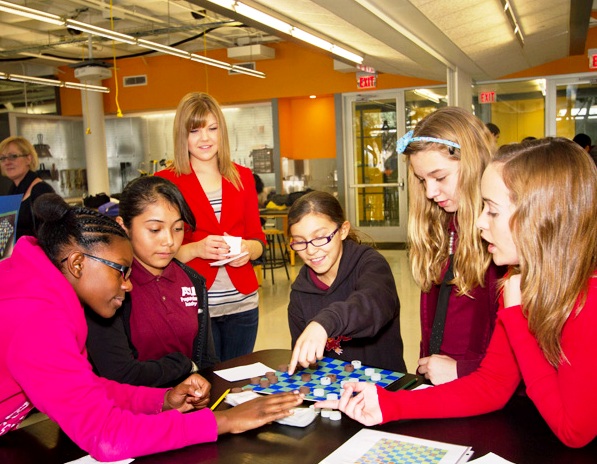
Toy design project gives youngsters hands-on introduction to engineering

ASU engineering students Kelsey Stopkey (center) and Julia King (far right) gather with six-grade students from ASU Preparatory Academy to examine a prototype for a game called Battle Plates, designed to teach geological concepts related to plate tectonics. It was one of several toy and game designs that ASU engineering students and youngsters from ASU Prep collaborated on. Photo: Jessica Slater/ASU
Posted January 28, 2013
Could designs for some of the next generation of toys that teach arise from a recent collaboration of freshmen students in Arizona State University’s Ira A. Fulton Schools of Engineering and a class of local sixth-graders?
Instructor Benjamin Mertz challenged the 29 freshman honors students in his Introduction to Engineering class to develop prototypes of toys that would help teach engineering, science and math at fifth- and sixth-grade levels.
Mertz stipulated that the toys be designed for use anywhere in world, including communities in undeveloped countries. That meant any electrical components of a toy would have to be capable of being powered by hand-crank generators or solar-energy cells.
Mertz’s class of aerospace, mechanical, chemical and electrical engineering majors teamed with 30 sixth-graders from the K-12 ASU Preparatory Academy, relying on the youngsters for insights on whether the toys being designed would be both fun and educational.
The ASU students visited ASU Prep, where they helped the sixth-grade class perform a design activity to demonstrate some fundamental principles of engineering.

ASU engineering student teaching assistant Katelyn Keberle (third from left) looks on as ASU Preparatory Academy students go over the rules for a game called Decimal Dynasty, which requires players to answer math questions to make progress on a journey to a castle. Photo: Jessica Slater/ASU
Later came interviews between the two classes of students, documents describing proposed toy designs, written feedback on the designs from the sixth-graders, and a progress report meeting on Skype between the two groups of students.
The collaborative endeavor culminated with Toy Expo day. The six-graders visited the mechanical and aerospace engineering machine shop on the ASU’s Tempe campus – where they got a look at a high-tech computer-controlled milling machine and a three-dimensional printer – before meeting the engineering class at the campus eSpace workshop. There the youngsters examined nine toy and game prototypes developed by Mertz’s students.
Designs ranged from a solar-powered device that would light up when the correct answer to a question is given, to a catapult that throws a ball at a target if the throwing arm is set to the correct length based on correct answers to board game questions that teach about the geologic time scale.
Another design required solving math problems to enable players to progress in a game called Math Monkeys, which featured hand-molded clay monkey heads as game pieces.
There were also variations of popular games like Jenga and Guess Who? adapted to incorporate math topics like prime numbers and decimal division.
“Working with ASU engineering students was an exciting and challenging opportunity for my students,” says ASU Prep teacher David Bennett. “We want to see our students graduate from college after they leave us. This project certainly helped to further that goal. It showed them in a very real, hands-on way the possibilities that engineering, science and technology can offer.”
Mertz now has an eye out for “opportunities for partnerships with organizations or companies that would help get these designs into classrooms around the world.”
The project achieved his immediate goal of giving his students experience in “reaching out to our local community and encouraging younger students to pursue college degrees, and considering the global impact that engineering can have,” Mertz says.
“It really represents the kind of impact we want our students to have while studying engineering at ASU,” he adds. “We want our students working to solve real engineering problems from day one.”
Written by Natalie Pierce and Joe Kullman
Media Contact:
Joe Kullman, [email protected]
(480) 965-8122
Ira A. Fulton Schools of Engineering



































